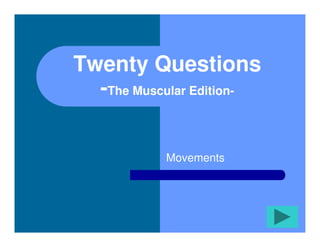
20questionsformusclephysiology
- 1. Twenty Questions -The Muscular Edition- Movements
- 2. Twenty Questions 1 2 3 4 5 6 7 8 9 10 11 12 13 14 15 16 17 18 19 20
- 3. 1. How do skeletal muscles provide movement/heat/posture Movement: During contraction of the muscles, bones are tugged and caused to move. With relaxation, the bones are at rest as well Heat: During the breakdown of ATP from food, heat is produced. It being released to maintain body temp. and warming the muscles/surrounding tissues. Posture: Receiving acetelecholine from a motor nerve triggers an action potential across the muscle fibers causing a contraction. -All these functions are unique to muscles due to the chemicals and self produced heat.-
- 4. 2. The characteristics of Excitability are shared with ______ The Nervous System (1)
- 5. 3. What has the ability to shorten; creating body movements? Contractility (Packet)
- 6. 4. What is the ability to elongate and then return to the primary state? Extensibility (Packet)
- 7. 5. Do they perform a specific movement? Agonist muscles (1)
- 8. 6. During contraction, they oppose prime movers? Antagonist (1)
- 9. 7. What are unique to skeletal muscle fibers? Slow red fibers, Fast white fibers and Intermediate fibers. (1)
- 10. 8) What are different structures that differentiate contractility and excitability? Fast fibers are involved in excitability while slow fibers are involved in contractility. (1)
- 11. 9. What are myofilaments? Four different types of protein molecules; myosin, actin, tropomyosin and troponin. Myosin heads are chemically attracted to actin molecules of nearby thin filaments, angling toward them. When bridging the gap between adjacent myofilaments, they’re then called cross bridges.” (1)
- 12. 10. What contributes to the sliding filament theory in shortening muscle? When a myofibril changes length, the area must slide past each other to increase their area to overlap. The myosin filaments do not move, but the actin filaments are pulled in. (Packet)
- 13. 11. What is the role of Ca++ in excitation? Ca++ is released from the SR into the sarcoplasm; binding to troponin molecules in the thin myofilaments. Tropomyosin molecules then shift and expose actin sites which in response, cross bridges are formed for pulling thin myofilaments out toward thte sarcomere. Repeats while the Atp is still available resulting in contraction. (1)
- 14. 12. What is the role of Ca++ in relaxation of a muscle cell? The Sr pumps Ca++ back into its sacs. As Ca++ is stripped from troponin molecules in thin myofilaments, tropomyosin returns to blocking the actin sites. The cross bridges are then prevented from attaching and can’t sustain the contraction. (Packet)
- 15. 13. What occurs within the muscle during an exercise burn? The myosin heads are attaching and moving to actin, causing the heads to be ripped off, which is the burning sensation. More, stronger heads grow in return. (Packet)
- 16. 14. What’s the anatomical arrangement of a motor unit? The motor unit consists of motor neurons as well as the muscle fibers to which it attaches. The gross motor unit consists of multiple neurons and muscle fibers, a fine motor unit consisting of less. Fine motor unit Gross motor unit
- 17. 15. What muscle would a marathon runner have? Marathon runner- 80% of their muscles are Slow fibers: produce atp quickly enough to keep pace with the energy needs of myosin; avoiding fatigue. 100- yrd dash- intermediate and fast fibers: contract rapidly and quickly deliver Ca++, aslo using Atp quickly, perfect for a short distance runner. (1)
- 18. 16. What is a unit of combined cells? syncytium being the branching exhibited by individual cells, that allows cardiac fibers to form a continuous, electrically coupled mass. I.e. cardiac muscle due to its low resistance connections between adjacent cells such as when an action potential is generated, the atria and ventricle contract together. (1)
- 19. 17. What is Rigor Mortis? Occurring several hours post someone’s death; the joints of the body stiffen and become locked in place due to the skeletal muscles partially contracting and not allowing the muscles to relax. (27)
- 20. 18. What four factors describe the Graded Strength Principle of muscles? Skeletal muscles contract with varying degrees of strength at different times. 1) The metabolic conditions of individual fibers 2) The number of fibers contracting simultaneously. Greater number=stronger contraction 3) The number of motor units recruited 4) The intensity and frequency of the stimulation (1)
- 21. 19. What are twitch contractions? A quick jerk of a muscle as a result of a single, brief threshold stimulus. The 3 phases involved are the – Latent Phase: a nerve impulse traveling to the sarcoplasmic reticulum, triggering the release of Ca++. – Contraction Phase: Ca++ binding to troponin and filaments sliding. – Relaxation Phase: When the filaments cease to slide (1)
- 22. 20. What does the treppe effect have to do with athletes? When athletes warm-up, the treppe is gradually increasing strength of contraction and relaxation phases will dissapear. (1)